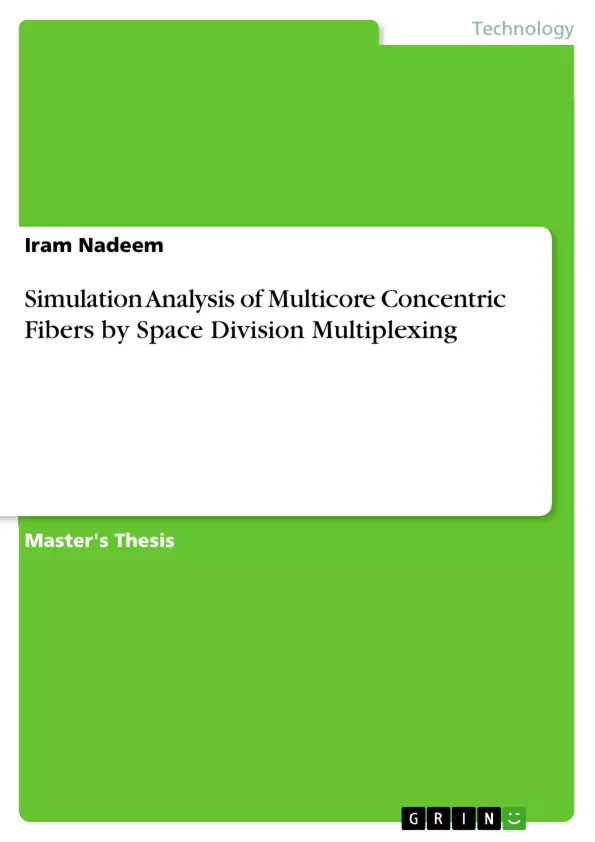Due to rapidly growing technological trends higher data rate support has become the key feature in future communication medium selection. Multi-mode optical fiber cable and Multi-core optical fiber is well matched for high data rate throughput requirements due to its tendency to support multiple modes through one core at a time which results in to higher data rates. But with multi-mode modal dispersion, crosstalk is the main limiting factor.
So in this research work we have investigated the fiber design parameters core diameter (µm), Wavelength (nm), refractive index profile to achieve Few mode fiber , their number of channels, curves of group delay, material losses , Bending losses , PMD and effective Nonlinear Refractive Index for each guided mode. Space Division Multiplexing is promising future technology which uses few mode fiber in parallel to form multicore fiber.
This research work also includes the calculation of radial distance, guided modes and there losses through 12 cores single mode fiber. Then designed a 12 cores few mode fiber with different refractive index and core diameter. These tests are done on standard 2nd window wavelength 1550 µm. Simulations and results of different designs according to standard area of 125µm have been presented in this thesis. Conclusion of this research is we can design concentric cores single mode fiber (CCSMF) up-to 4 layers within 125 µm , and can enhance bandwidth of fiber. Concentric core Fiber can be used for military purpose i.e. inner core can be used for message signal whereas outer cladding will keep alarm signal in it.
Inhaltsverzeichnis (Table of Contents)
- INTRODUCTION
- HISTORY OF COMMUNICATION SYSTEMS
- Usage of Glass Material
- Advent of Optical Fiber
- PROBLEM STATEMENT
- PROPOSED WORK
- ORGANIZATION OF THESIS
- LITERATURE REVIEW
- SPACE DIVISION MULTIPLEXING
- Approaches to Execute SDM
- SINGLE MODE FIBER (SMF)
- Multi-Core Single Mode Fiber (MC-SMF)
- MULTI-MODE FIBER (MMF)
- MULTI CORE FIBERS (MCF)
- Collected work on MCF
- FEW MODE FIBER (FMF)
- Motivation behind FMF
- Few-Mode Fiber Manufacturing
- Literature of FMF
- Classes of Few-Mode Fiber Devices
- DEFINITION, GENERATION AND SHAPES OF LINEAR POLARIZED MODES
- OPTICAL FIBER
- FIBERS MODES
- Standard Description
- Linearly polarized (LP) mode
- TYPES OF MODES
- Guided Modes
- Radiation Modes
- Leaky Modes
- MAXWELL's EQUATIONS
- Interpretation of Maxwell's Equations
- Some important parameters of LP modes are as follows:
- Phase Velocity
- Group Velocity
Zielsetzung und Themenschwerpunkte (Objectives and Key Themes)
This thesis explores the potential of multi-core concentric fibers, particularly few-mode fibers, for achieving higher data rates in future communication systems. The research focuses on analyzing the design parameters of these fibers, including core diameter, wavelength, and refractive index profile, to optimize their performance in terms of modal dispersion, crosstalk, and other relevant factors. The objective is to demonstrate the feasibility of employing space-division multiplexing (SDM) techniques with these fibers to enhance bandwidth and meet the growing demands for high-speed data transmission.
- Space Division Multiplexing (SDM) for High Data Rate Communication
- Optimization of Multi-core Concentric Fiber Design Parameters
- Analysis of Modal Dispersion, Crosstalk, and Other Relevant Factors
- Investigation of Few-Mode Fiber Properties and Applications
- Simulation and Evaluation of Concentric Core Single Mode Fiber (CCSMF) Designs
Zusammenfassung der Kapitel (Chapter Summaries)
- Introduction: This chapter provides an overview of the historical evolution of communication systems, highlighting the advent of optical fiber and its role in enabling high-speed data transmission. It also outlines the research problem, the proposed work, and the organization of the thesis.
- Literature Review: This chapter presents a comprehensive review of existing research on SDM techniques, single-mode fibers, multi-mode fibers, multi-core fibers, and few-mode fibers. It discusses the motivations behind employing few-mode fibers, their manufacturing processes, and the various classes of few-mode fiber devices.
- Definition, Generation and Shapes of Linear Polarized Modes: This chapter defines optical fiber modes, particularly focusing on linearly polarized (LP) modes. It delves into the different types of modes, including guided modes, radiation modes, and leaky modes. The chapter also introduces Maxwell's equations and their interpretation in the context of fiber optics. Finally, it discusses important parameters of LP modes, such as phase velocity and group velocity.
Schlüsselwörter (Keywords)
This research focuses on the design and analysis of multi-core concentric fibers, particularly few-mode fibers, for high-speed data transmission using space-division multiplexing (SDM). The key keywords include: multi-core fiber, few-mode fiber, concentric core single-mode fiber (CCSMF), space-division multiplexing (SDM), modal dispersion, crosstalk, refractive index profile, core diameter, wavelength, bandwidth enhancement.
- Quote paper
- Iram Nadeem (Author), 2017, Simulation Analysis of Multicore Concentric Fibers by Space Division Multiplexing, Munich, GRIN Verlag, https://www.grin.com/document/359277



